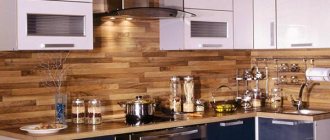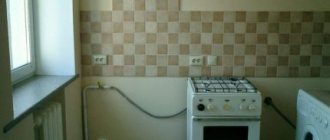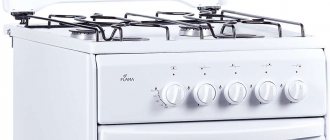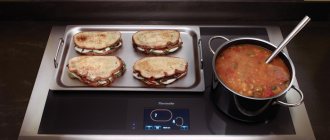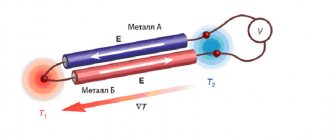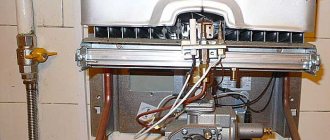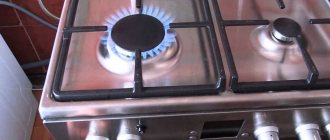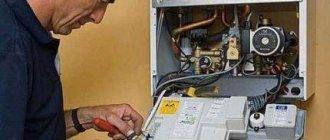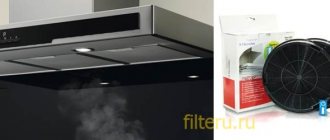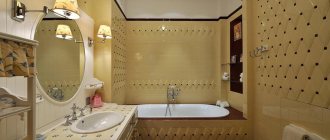- Design of a standard hood
- Types of hoods
- How to determine the mounting height of the hood
- Basic rules for installing a hood
- Hood installation options
- Hood attached to the bottom of the cabinet
- Installation of a hood in a wall cabinet
- Rules for installing a hood with an air duct
The functionality of home exhaust ventilation ducts almost always left much to be desired. They did not cope with their main task - extracting waste air and unpleasant odors from the kitchen area. That is why such useful and necessary devices as hoods were subsequently invented, which were much more effective than ducts. When planning to install new kitchen equipment, many people wonder at what height to hang the hood? Does it matter. The performance and quality of its operation often depend on the height at which the device is mounted.
Installation of air ducts and power supply connections
Hood with corrugated air duct
When installing the air duct, we advise you to pay attention to the following important details:
- outlet channels for a wall-mounted kitchen hood are made up of relatively short and straight sections with a minimum number of bends, the radius of which should be chosen as large as possible;
- when using corrugated hoses as a discharge channel, their bending angle should not be less than 90 degrees;
- It is also not recommended to narrow the outlet section of the air duct, which can lead to increased noise;
- The hatch of the ventilation shaft to which the air duct is connected must be completely cleaned of all contaminants accumulated during its operation.
The operation of the exhaust mechanism requires an electrical network, the supply of which must be provided in advance. As a rule, products of this class are equipped with a cord with a plug, for connecting which a specially equipped socket with a grounding contact must be used.
Important! To avoid heating, such an outlet should not be located above the area where the hood is located.
Number of sockets
How many minimum outlets are required in the kitchen?
Here, follow the rule - for each stationary kitchen appliance, plan your own socket + 2 blocks along the edges of the countertop + 1 piece near the dining table.
In addition, it doesn’t hurt to mount one socket immediately under or near the switch at the entrance to the room.
The area with switches usually remains uncluttered, and a free point where you can take voltage (for example, for a vacuum cleaner) is never superfluous.
Now mark the points on the apron for connecting non-stationary devices. Place at least two pieces on each part (right and left) of the kitchen.
This will include an electric kettle, blender, mixer, etc.
Hood installation height standards
Distance from the hood to the stove
The distance from the hob to the hood is determined by the type of cooking equipment and the location of the ventilation unit.
Moreover, the design features of the device, the size of the air vent or the presence of additional elements on the panel do not affect this indicator. An exception may be when the ceiling height in the room does not allow all recommendations to be followed.
First of all, you should take into account the height recommended by the manufacturer, adjusting it by 10 cm up or down.
Installation height of the hood above the gas stove
The optimal distance from the hob to the ventilation is determined by system manufacturers and specialists in the field. Ventilation system installation standards are based on practical experience, so it is worth adhering to them in order to improve the performance and increase the safety of use of the device.
To decide at what height to hang the hood above a gas stove, you should refer to the accepted standards:
- for inclined systems, the suitable location of the hood above the stove is 0.55-0.65 m;
- other models are located at a height of 0.75-0.85 m.
The height of the hood above the gas stove according to the standard differs from similar parameters for other types of working surface. This is due to the peculiarities of the operation of a gas stove - if the hood is positioned low, soot may form on it.
There is also a risk (albeit very small) of ignition of greasy stains formed on the equipment body.
Installation height of the hood above an induction or electric stove
Everything is much simpler here, because the operation of an induction cooker does not involve the use of open fire, so the hood is installed at a shorter distance. The installation height of the hood above the electric stove can be:
- 0.35-0.45 m for inclined models;
- 0.65-0.75 m when installing other ventilation systems.
When installing a ventilation system, do not forget about ease of use - any distance is adapted to the specific user.
Mounting height of inclined models
Inclined hoods are easy to use:
- for tall people - it will not become a hindrance during cooking;
- for small rooms, because visually such a housing occupies a smaller area, which significantly increases the space.
Another advantage of this design is that it does not protrude beyond the working surface and does not look bulky.
Features of installing other types of hoods
Distance of different types of hoods to the stove
In addition to inclined ones, users actively use the following types of models:
Built-in system - installed directly into the cabinet. Model of small depth with a retractable part.
T-shaped and dome. Their difference lies only in visual perception. The use of dome ventilation systems will be advisable in spacious rooms - for a small kitchen such a model is too bulky. Another name for such hoods is fireplace hoods. This is the word marketers use to promote their products on the market. Such hoods often do not clean, but pump out the exhaust air.
Flat - this is the smallest system in terms of power. Takes up very little space - can be attached above the electric stove directly under the kitchen cabinet. Perfect for a small kitchen. The best devices in this category have a retractable panel that increases the working area of exhaust air intake, making it more efficient without taking up additional space.
Island - installed in large rooms when the stove is located away from the wall.
Regardless of the model chosen, the distance above the hob must comply with the standards specified above. This will ensure safe use of the system and make it as efficient as possible.
Typical ventilation problems
Natural ventilation of residential buildings was based on the presence of microgrids, characteristic of wooden window structures. Through these small openings, air was regularly brought in from outside and removed from the house through ventilation ducts built into the structure of the building.
Thus, there was a constant exchange of air masses in the apartment, helping to maintain a normal level of humidity, eliminate unpleasant odors, etc.
Regular exchange of air mass, which occurs naturally through the free fittings of window and door sashes and ventilation, creates an optimal microclimate for life and removes excess moisture, carbon dioxide and other harmful toxic substances.
Insufficient air exchange in the house is an almost inevitable problem when taking measures to reduce heat loss. When installing new windows and doors to minimize heat loss, few people think about ventilation in their home.
But soon problems appear in the form of a stuffy atmosphere, the development of mold in the bathroom and other similar phenomena. Soon the abnormal microclimate begins to negatively affect the health of those who live in such a house.
Various types of ventilation units help to cope with excessive tightness of rooms, but this may not be enough for proper ventilation.
The rate of natural exhaust ventilation is often weak or even absent. Due to problems with the construction of ventilation structures, part of the air masses that should be removed from the house is forced back.
Lack of ventilation or insufficient ventilation is not only dangerous to human life. Moisture that condenses on surfaces and is not removed by ventilation causes premature damage to structures, communications, and finishing.
The state of draft in the ventilation system of a house or apartment is also affected by the temperature of the outside air, or more precisely, the difference between the internal and external temperatures.
In winter, this gap is large enough to provide good traction. However, in summer the temperature difference between the outside and inside air is not so significant and does not have a very good effect on the quality of draft.
For these reasons, the installation of special exhaust valves should be considered. They will ensure fast and effective removal of exhaust air from the home and prevent its re-entry.
Types of hoods
There are four main types of kitchen hoods:
- Wall-mounted fume hoods;
- Island hoods;
- Built-in structures;
- Desktop devices.
The first type looks like an umbrella with a pipe, which is mounted on the wall where it is clearly visible. Therefore, its design should suit the interior of the kitchen. Outwardly, it is very similar to a chimney from a fireplace.
Island-type devices are most often attached to the ceiling. They are used if the kitchen interior is designed so that the stove is located in the center of the room. This model operates only in one mode, based on the air exhaust principle.
Built-in appliances are placed inside cabinets. They are hidden from view, so they do not need to be trimmed too carefully. Their technical characteristics are no worse than those of other models, but they cost a little less.
Hood installation height calculations
Tabletop structures are built into the hob itself. They look like another panel section. Due to the fact that this model is located in close proximity to the source of dirty air, the quality of cleaning is usually high.
How can you check the performance of ventilation?
To check the operation of the installed device, follow these steps:
- Open the apartment window a little and open the door to the toilet or bathroom.
- Take one napkin.
- Then apply the cloth to the vent shaft hole.
- The fabric sheet should fit snugly into the hole. If the sheet does not stick to the hole, think about why this is happening. This could be a seriously clogged duct. In apartment buildings, the cause of a clogged chimney may be an air duct clogged by upstairs neighbors.
You can also check the ventilation draft with a match, candle or lighter. The flame of the lighter should swing towards the stem. It is believed that the greater the deflection angle, the better the ventilation.
It should be remembered that in hot weather, when the air is quite heavy, it stagnates in the exhaust duct and can significantly impair the quality of draft control.
After inspection, it is recommended to close open windows and doors and repeat the exhaust ventilation test. This way you can find out whether additional equipment is required to implement microventilation.
If you find that there is no air flow, you can install a small grille on the door or wall surface.
The main thing is to take into account that ventilation in the toilet in a private house is necessary; it will always keep the room dry, thereby increasing the period of repair of the room.
Important rules for installing a hood
If you are planning to mount the air intake yourself, study in advance the rules that guide the installation. This is especially true for the standards and requirements for the height of the hood above a gas stove:
- The width of the hood and the size of the hob should always match for optimal performance of their functions, or be slightly larger. The main requirement is that it is no narrower than the slab.
- According to standards, the distance from the hood to the stove depends on the type of hob, as specified in the instruction manual.
- Install the outlet to which the device is connected as far as possible from the stove. It’s good when it is located above the kitchen unit or hidden behind the cabinet doors. Wires must be placed far from sources of ignition.
- There should not be many corners and turns in the duct itself and the place where the hood is connected to the air duct. Otherwise, the air, encountering many obstacles, will escape with difficulty and unnecessary noise.
- It is necessary to observe the standards for the height of the hood above the gas stove, which are described in the instructions for the equipment in order to avoid fire. There are no general distance limits according to GOST from a gas stove to a kitchen hood, but they exist for every manufacturer. You can familiarize yourself with them in the operating manual. It is worth adhering to these recommendations when determining the height of the hood above the gas stove.
- If there is no ventilation shaft, you should choose the circulation option. It is much easier to install.
Why does the valve freeze up?
This phenomenon occurs in areas with low winter temperatures. The source of frost is condensation falling on the very cool surfaces of the fan. To fix the problem, you need to determine the cause of the freezing:
- The natural exhaust gas removal system is ineffective or does not work at all. Result: water vapor remains inside the room and partially escapes outside through the supply valve.
- The power of the heating system is not designed for infiltration (influx of natural air) by the supply unit. The heater overcools and condenses.
- Incorrect installation, for example the fan is too close to the window, too far from the radiator or insufficient pipe insulation.
- The interior drapes too tightly, resulting in a cold zone along the wall. Frost accumulates on the cover.
Among the opinions of users there are complaints about a decrease in temperature after installing fans, literally strong shocks from the valves. We remind you of a simple rule: the passage of air through the element depends only on the operation of the hood. Try adjusting the flow at the wall damper or partially closing the outlet.
The photo on the left shows the correct installation of the fan, cold air is mixed with the warm flow from the radiator. On the right, the valve is too low.
Installation features
The technology for installing a kitchen hood may vary depending on the design features of such equipment.
Correct self-installation involves performing a whole range of work, including:
- direct installation of the device;
- connection to the electrical network;
- installation of an exhaust pipe;
- connection to the ventilation duct.
Today, the following options for installing an exhaust device are acceptable:
- Installation based on recirculation involves hanging the hood at the height recommended by the manufacturer and fire regulations and installing special plugs in a pair of air duct outlets. As a result of this arrangement, the air exits through a special housing grille.
- Traditional installation with cutting through the wall. The rear wall of the body of a standard kitchen hood has a hole through which combustion products are discharged directly into the ventilation shaft. The hole located on the surface of the case must be covered with a special plug.
- The simplest and most popular installation option involves using a round ventilation hole located on the top surface of the case. An exhaust duct connected directly to the general building ventilation shaft is connected to this hole. In this case, the plug is used to close the hole located on the rear panel of the equipment.
The stage of independently connecting already installed kitchen equipment to the electrical network requires special attention.
It is important to note that some range hood models are sold without a plug at the end of the power supply wire, so in this case a connection via a terminal block is often used. However, the easiest way is to purchase the required plug and install it yourself.
Hood installation diagram
Inside the body of the exhaust device there is a special free space, which is intended for connection cables and allows you to get a very aesthetic appearance of the device. When installing a hood built into furniture, it is advisable to connect the electrical supply above the body. The kitchen hood must be connected to the electrical network using the “phase”, “ground” and “zero” wires.
One of the main conditions for obtaining a high-quality exhaust device is the correct choice of air duct. Aluminum round corrugation is a budget-friendly and easy-to-install option with dubious aesthetics. Experts recommend using air ducts made of durable plastic, which have an attractive appearance and decent performance.
Calculation of the power of the exhaust device
According to SNiP 2.08.01-89, the rate of removal of treated air for 4-burner stoves is 90 or more cubic meters per hour. GOST 26813-99 requires ventilation units to have a capacity of 200 m³/hour.
But the installation of mechanical (forced) ventilation in the kitchen is required by SNiP 2.04.05-91.
Before selecting height and installation, determine the required capacity. Installing a weak system in a large kitchen is a waste of money.
The minimum power for effective air purification is determined by the formula N=S×h×12×1.3 , where:
- S - kitchen area;
- h is the height of the ceilings in the room;
- 12 - the number of times you need to refresh the air in the kitchen within an hour;
- 1.3 is the equivalent of 30% - an approximate indicator of power loss due to air movement through bends, connections, openings and filters.
A small margin is added to the result obtained even without the indicated 30 percent, because the calculation of the performance of hoods by manufacturers can be inaccurate.
Owners of medium-sized kitchens should focus on models with a capacity of 350, 400, 450 and 500 m³/hour. The indicator is selected no more than the throughput of the built-in ventilation ducts used.
The table shows the minimum required hood power in m³/hour (rounded to whole numbers) according to the already described formula N = S × h × 12 × 1.3 - with indicators of kitchen area, ceiling height and other factors - calculations are suitable for kitchens with door
The “12” multiplier can be increased to 20 if the stove is gas and has increased power. It is also increased for electrical appliances, also according to performance criteria (up to 15). The minimum coefficient value is 10.
The path of the air hose is laid so as not to block the built-in ventilation grille. Complex geometry and long distances of air duct sections are avoided.
In apartments, communication to the opening to the street cannot be laid without permission. You can read more about the intricacies of choosing hoods in this material.
General requirements, rules and standards for installing hoods
There are general rules that should be followed during the installation of any exhaust systems. The main thing is compliance with the manufacturer’s requirements and established standards. The instructions for any model always contain recommendations on the optimal distance to the stove. As a rule, you can vary these parameters within 10 cm depending on the height of the housewife or the characteristics of the furniture design. The standards were developed to prevent fires to maintain fire safety. The width of the hood must match the width of the hob. If the suction surface is smaller than the area of the stove, effective air purification will not occur.
Installation features and height above the gas stove
Of all types of stoves, it is the gas stove that puts forward the most serious requirements for the installation and placement of the hood. It is unacceptable to ignore standard recommendations, since their failure to comply creates a real threat to the lives of both the individual family and the other inhabitants of the building.
Let's start with the fact that using a gas stove implies the presence of an open fire in the room. Any devices and structures placed above them must be removed from the surface at a distance of 75-85 cm.
When installing the air duct, you must remember that it is unacceptable to completely close the ventilation hole. Gas accumulated in the room as a result of an accident or improper handling of the stove must be able to escape freely. If a separate outlet to the ventilation duct is not provided, the existing one should be divided into two parts. This is achieved by installing a special grille divided into two sections. In one part there is a hole for the pipe, the second has standard jumpers.
Installation features and height above electric and induction hobs
The requirements for installing hoods over electric and induction hobs are somewhat milder. This mainly relates to recommendations for placing the device at a certain height above the stove. In this case, it is allowed to install the hood a little lower - at a distance of 65-75 cm.
Installation features and height of inclined hood
Inclined hoods are indispensable in miniature rooms, where the issue of maximizing the preservation of free space is acute. When installing an inclined hood over a gas stove, the requirements are slightly different. The lower edge of the surface should be at a distance of 55-65 cm from the gas oven. You only need to step back 35-45 cm from an induction or electric stove.
Recommendations for use
Proper care of the exhaust system can extend its service life. Manufacturers recommend:
Clean the grease filter regularly. It is removed by releasing the spring lock. Can be washed in the dishwasher or under running water and soap. Change carbon filters every 2-3 months. Checking their status is only allowed when the system is turned off.
Use the hood with caution in rooms where a gas stove and fireplace are operating simultaneously. The ventilation system removes the air needed to support combustion
At this time, additional ventilation of the room is required. To avoid burns, it is not recommended to touch the lamp after finishing work.
Disconnect the device from the electrical network only with dry hands. Do not pull on the cord.
Installation of a hood in a wall cabinet
A hole is made in the bottom of the cabinet, the size of which corresponds to the size of the kitchen hood. The hood island is hidden in a cabinet. Fastening is carried out using holes in the lower edge, with the help of which the hood is screwed to the bottom of the cabinet.
Kitchen hood installed correctly
In the shelf located in the middle of the cabinet, as well as in the ceiling, holes are made for the passage of a hose, one edge of which is attached to the hood, and the other is inserted into the hole in the central shelf and ceiling. In the mode when the air is discharged into the ventilation vent, the hose is passed into it, and in the filtration mode, on the contrary, it is cut off near the exit from the hole.
Installation options for kitchen hood LC958WA60
It is curious that the designers propose not to lay any air ducts at all... In combination with the removal of cooking products, use check valves as necessary. When the hood is turned off, this mechanism will not allow air masses from the ventilation shaft (or from the street) into the kitchen.
Decide at what height to hang the hood, and then drill a hole through the wall to the outside. This procedure provides one of the installation options. The hole is round, in the shape of the corresponding outlet of the upper section of the cabinet for the kitchen hood.
It is understood that we have a private cottage, and we make holes in the walls as we want. As a result, there will be only one turn of the exhaust tract, which will reduce productivity by 10%. Another concern is what to do when the equipment does not work. The fact is that in a cold climate, the air from behind the wall will immediately rush inside. This option seems suitable for warm climates or restaurant kitchens.
In the latter case, we will install a steel hatch on the outside and close it after the end of the working day. Even if thieves manage to open it, no one will be able to crawl through the hole with a diameter of 15 cm. But it will be possible to set the establishment on fire, so act wisely in our criminalized country.
The second option is less productive and radical, but safe. You will have to hammer the wall, and in the same place. But in this case it is assumed that the vertical duct of the ventilation system passes through the interwall. We punch a hole up to it and get two bends (these are only those that are visible). As a result, we lose 20% of productivity.
But the mansions are no longer accessible to thieves, as are arsonists, and in winter, cold air will not enter the premises. But the vertical duct of the ventilation system does not always pass behind the wall. In this regard, we note that the owners of private cottages are free to dispose of the property at their own discretion, so even if the project did not provide for the creation of a vertical duct of the ventilation system, reconstruction can be carried out.
Please note that the previous installation options require a telescopic kitchen hood cabinet. This case also provides for the presence of such
But now we will remove combustion products through a round air duct upward. We don’t suggest breaking through the ceiling at all, if some people have come up with this idea. The manufacturer wisely keeps silent about how to carry out these actions.
It is possible to carry out the same corrugation behind artificial plasterboard decor or use rigid air ducts. In the latter case, there will be a lot of turns that will reduce performance. But it’s not so easy with corrugation either. The inner surface is ribbed. Dust and grease settle on it. In addition, a lot of air resistance is formed. That is why it is recommended to use corrugated air ducts in a straightened form, which is not always possible.
Fastening is carried out with special clamps. It is better if there is a grille with a check valve. This allows you to simultaneously connect the exhaust outlet to the ventilation hole in the kitchen and does not interfere with ventilation.
This manufacturer has thought of everything. If a telescopic cabinet is not needed. For example, if it does not fit into the hanging section of the furniture where you are planning to place the hood, then you can not use the telescopic cabinet at all. Even in this case, there are two options:
- air duct with a diameter of 150 mm (standard);
- air duct with a diameter of 120 mm.
The installation height of the kitchen hood is the same as before, but now the air ducts are attached to the body. If necessary, use a special plastic adapter. In this case, beauty restoration falls on the shoulders of the owner of the kitchen hood. If earlier a telescopic cabinet created a charming picture, now it is our concern.
What type of air duct we will install is also purely our business. This is both breadth for improvisation and at the same time.
The last installation option concerns working with recirculation. We already know at what height to install the hood; all that remains is to attach a telescopic cabinet to the body so that it reaches the ceiling and make sure that the special outlet grille on the lower section is not blocked.
Don't forget to check that the filters are in place. If the previous options made do with, in extreme cases, a pipe for discharging combustion products, now the kitchen hood will throw the products back into the kitchen. It won't clean anything.
Take care to keep the filters clean. We have already mentioned how this is done, but the recommendations were general. It is much better to read the instructions that come with the kit, which indicate at what height to mount the hood and how to properly care for the equipment.
Types of air ducts
There are three types of exhaust pipes:
Corrugated aluminum. The easiest to install. Usually it is enough to buy one such pipe, stretch it to the required length, put it on the flanges and secure it with clamps. The ribbed surface creates turbulence and air noise can be clearly heard.
Plastic round. Installation will require the use of elbows and possibly couplings. It will be necessary to cut the pipe sections to the required size. Air passes through such pipes with the least turbulence and noise.
Plastic rectangular. You can lay it flat on the top of the cabinets so that they will not be visible. If the walls are sheathed with panels or plasterboard along the sheathing, then it is possible to lay such pipes behind the panels.
For each type and size of pipes, it is necessary to buy suitable ventilation grilles, which are attached to the vent opening, and to which the pipe, in turn, is attached.
If the air duct is longer than half a meter, you will also need to install intermediate supports. Special supports are available for various types of pipes, but it is also possible to use metal mounting tape with perforations and universal clamps.
Air exhaust can be carried out into an existing ventilation system, or into one installed specifically for exhaust hood. To control the air flow, valves can be installed to prevent its movement when the hood is turned off.
Height from the stove to the inclined and horizontal hood
Before you understand at what distance from the stove to install the hood, it is necessary to consider the main types of exhaust devices, which is the main factor when calculating the distance.
As for the operating mode, there are the following three types, which have their own characteristics:
- Recirculation - a hood that sucks in air using fans, passes it through carbon and grease filters and returns fresh air back to the kitchen;
- Flow-through - a hood that sucks in exhaust air, drives it through a grease filter and directs it outside the house using ventilation ducts;
- Combined - a universal option, the mode of which can be switched using the control panel.
According to their form, the following types of hoods are distinguished:
- Built-in (installed in a cabinet or other object);
- Island (used in large kitchens);
- Suspended (flat hood that is installed above the stove);
- Retractable (a type of built-in type).
An important criterion: according to the shape of the air intake, hoods are divided into the following types:
- Inclined;
- Horizontal.
When choosing the height of the hood installation above the stove, you must remember that it is important to take into account the dimensions and shape of each type of device for installing the equipment strictly above the hob. Hood manufacturers recommend the following hood heights above the stove:
They look like this:
Hood manufacturers recommend the following hood heights above the stove. They look like this:
- It is best to place a horizontal hood at a distance of 80 cm;
- It is best to install an inclined hood at a distance of 60 cm;
- If the hood is straight above an electric stove, then the distance is 70 cm, the inclined hood is 50 cm.
It is important to note that the indicators are calculated for an average kitchen with an average person’s height, so it is necessary to individually calculate the height so as not to experience inconvenience while cooking
Inclined hoods
So, at what height are inclined type hoods hung? The design feature of such exhaust devices speaks for itself: the air is absorbed by fans located in the upper part of the case. Accordingly, the equipment must be installed lower than the horizontal type.
The manufacturer recommends hanging the hood above the stove at a distance of 60 cm. This is the optimal indicator that will allow you to maximize the potential of the device. Also, at this distance the body will not interfere with a person while cooking.
The inclined principle of the housing structure is very convenient, because the user has more opportunities to dismantle the filter for subsequent cleaning or replacement.
Also, inclined hoods have a minimal risk of fire. The fire rises straight up, so contact with the device will be minimal.
If the choice fell on a built-in inclined type hood, then it is important to take into account the height from the stove to the installation of the kitchen wall, so it is best to develop a kitchen equipment plan in advance
Horizontal devices
What is the distance from the hood to the stove? The distance of the horizontal type hood above the hob differs from the above example. Manufacturers indicate 80 cm in the technical documentation for the device.
However, many models differ in their performance. For example, a weak exhaust device must be located lower to cope with the exhaust air draft.
It is also important to take into account the height of the ceilings, because if you install the hood close to the ceiling, there will be no space left to connect the housing with the elements of the ventilation system, which is important for the normal operation of flow-type equipment. Also, you should not strictly invest in sizes if a person’s height is above average.
Cooking should be fun and comfortable. That is why you should correctly calculate the most acceptable height
Also, you should not strictly invest in sizes if a person’s height is above average. Cooking should be fun and comfortable. That is why you should correctly calculate the most acceptable height.
It is recommended to take responsibility when choosing island hoods. The distance must be calculated before purchasing, because later it may turn out that the dimensions of the device do not coincide with the optimal distance between the hood and the stove (gas or electric).
Where should the outlet be installed?
Sockets are installed in accordance with the requirements of the state standard. Manufacturers recommend deciding in advance the location of the hood and connecting the power source to the required distance before installing the device.
When laying electrical wiring, you must adhere to the following rules:
- avoid a large number of bends, which increase the load on the exhaust device;
- ensure the tightness of the pipes in which the wiring is laid;
- Bring the socket as close as possible to the equipment being installed.
In addition, you need to consider the size of the load experienced by the electrical grid. Modern hoods consume little electricity. But if there are many appliances installed in the apartment (house), then it is recommended to connect a separate line from the electrical panel for the device that ensures air exhaust from the kitchen. This will reduce the load on the network.
Types of kitchen hoods
Hood in the kitchen interior
Currently, the domestic market of household appliances offers a wide range of kitchen hoods, which, according to their design, are divided into the following types:
- suspended design, which is one of the most convenient to install and practical exhaust devices, suitable for most ordinary users. With all the listed advantages, such a hood, however, is characterized by insufficient productivity;
- an exhaust device built into the walls or ceiling that provides the required efficiency in removing odors and fumes from rooms of a large area;
- an exhaust device designed in the form of a dome, the effect of which extends not only to the stove, but also to the working surfaces of the countertop located near it;
- the so-called “island” hood, mounted in the center of the kitchen space and providing air exchange throughout its entire volume (including above the gas stove).
What does poor ventilation in an apartment lead to?
Decades have passed since the current SNiPs were developed. Most apartments and houses today have plastic windows and metal entrances that are almost 100% sealed. This creates serious problems for the natural circulation of air in the home.
Ineffective ventilation causes gas to accumulate in the event of an emergency leak, which in turn creates an explosive situation.
In addition, the lack of normal air exchange leads to other negative consequences:
- The concentration of harmful substances increases, primarily carbon dioxide from breathing and carbon monoxide from cooking in the kitchen.
- A high concentration of water vapor leads to the formation of condensation on the windows, walls and ceilings of the apartment, which causes the development of mold, the appearance of a rotten smell and dampness in the house.
- A damp, moldy atmosphere is an ideal breeding ground for many pathogens.
Please note! Inadequate or no ventilation inevitably affects the health and daily well-being of residents, especially children and the elderly.
You can solve this problem in the warm season by opening the blinds and windows, but in winter this opportunity disappears, especially if there are children at home. The only favorable solution to the problem is to organize an air supply and exhaust system inside the apartment with your own hands.
